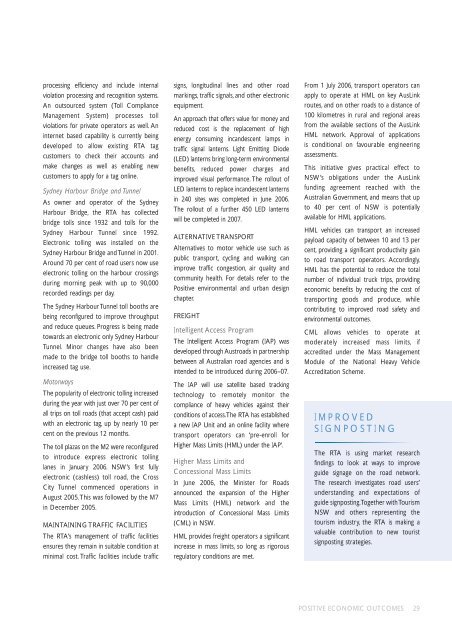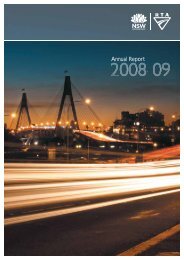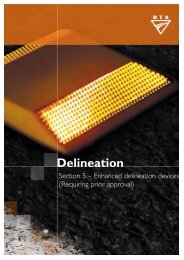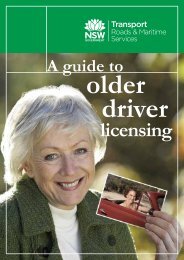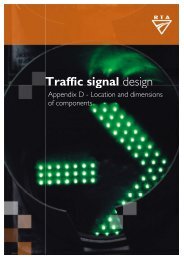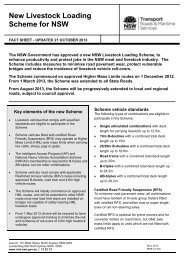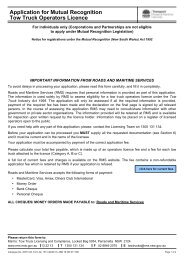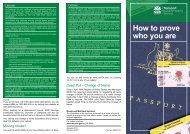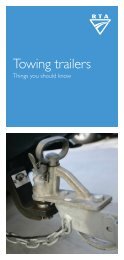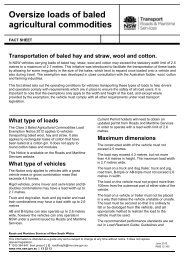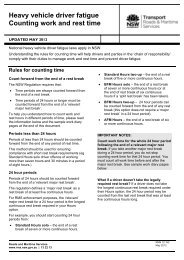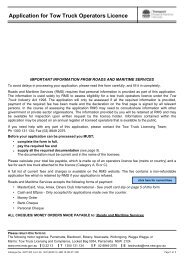Annual Report 2006 (main body) - RTA - NSW Government
Annual Report 2006 (main body) - RTA - NSW Government
Annual Report 2006 (main body) - RTA - NSW Government
Create successful ePaper yourself
Turn your PDF publications into a flip-book with our unique Google optimized e-Paper software.
processing efficiency and include internal<br />
violation processing and recognition systems.<br />
An outsourced system (Toll Compliance<br />
Management System) processes toll<br />
violations for private operators as well. An<br />
internet based capability is currently being<br />
developed to allow existing <strong>RTA</strong> tag<br />
customers to check their accounts and<br />
make changes as well as enabling new<br />
customers to apply for a tag online.<br />
Sydney Harbour Bridge and Tunnel<br />
As owner and operator of the Sydney<br />
Harbour Bridge, the <strong>RTA</strong> has collected<br />
bridge tolls since 1932 and tolls for the<br />
Sydney Harbour Tunnel since 1992.<br />
Electronic tolling was installed on the<br />
Sydney Harbour Bridge and Tunnel in 2001.<br />
Around 70 per cent of road users now use<br />
electronic tolling on the harbour crossings<br />
during morning peak with up to 90,000<br />
recorded readings per day.<br />
The Sydney Harbour Tunnel toll booths are<br />
being reconfigured to improve throughput<br />
and reduce queues. Progress is being made<br />
towards an electronic only Sydney Harbour<br />
Tunnel. Minor changes have also been<br />
made to the bridge toll booths to handle<br />
increased tag use.<br />
Motorways<br />
The popularity of electronic tolling increased<br />
during the year with just over 70 per cent of<br />
all trips on toll roads (that accept cash) paid<br />
with an electronic tag, up by nearly 10 per<br />
cent on the previous 12 months.<br />
The toll plazas on the M2 were reconfigured<br />
to introduce express electronic tolling<br />
lanes in January <strong>2006</strong>. <strong>NSW</strong>’s first fully<br />
electronic (cashless) toll road, the Cross<br />
City Tunnel commenced operations in<br />
August 2005.This was followed by the M7<br />
in December 2005.<br />
MAINTAINING TRAFFIC FACILITIES<br />
The <strong>RTA</strong>’s management of traffic facilities<br />
ensures they re<strong>main</strong> in suitable condition at<br />
minimal cost. Traffic facilities include traffic<br />
signs, longitudinal lines and other road<br />
markings, traffic signals, and other electronic<br />
equipment.<br />
An approach that offers value for money and<br />
reduced cost is the replacement of high<br />
energy consuming incandescent lamps in<br />
traffic signal lanterns. Light Emitting Diode<br />
(LED) lanterns bring long-term environmental<br />
benefits, reduced power charges and<br />
improved visual performance. The rollout of<br />
LED lanterns to replace incandescent lanterns<br />
in 240 sites was completed in June <strong>2006</strong>.<br />
The rollout of a further 450 LED lanterns<br />
will be completed in 2007.<br />
ALTERNATIVE TRANSPORT<br />
Alternatives to motor vehicle use such as<br />
public transport, cycling and walking can<br />
improve traffic congestion, air quality and<br />
community health. For details refer to the<br />
Positive environmental and urban design<br />
chapter.<br />
FREIGHT<br />
Intelligent Access Program<br />
The Intelligent Access Program (IAP) was<br />
developed through Austroads in partnership<br />
between all Australian road agencies and is<br />
intended to be introduced during <strong>2006</strong>–07.<br />
The IAP will use satellite based tracking<br />
technology to remotely monitor the<br />
compliance of heavy vehicles against their<br />
conditions of access.The <strong>RTA</strong> has established<br />
a new IAP Unit and an online facility where<br />
transport operators can ‘pre-enroll for<br />
Higher Mass Limits (HML) under the IAP’.<br />
Higher Mass Limits and<br />
Concessional Mass Limits<br />
In June <strong>2006</strong>, the Minister for Roads<br />
announced the expansion of the Higher<br />
Mass Limits (HML) network and the<br />
introduction of Concessional Mass Limits<br />
(CML) in <strong>NSW</strong>.<br />
HML provides freight operators a significant<br />
increase in mass limits, so long as rigorous<br />
regulatory conditions are met.<br />
From 1 July <strong>2006</strong>, transport operators can<br />
apply to operate at HML on key AusLink<br />
routes, and on other roads to a distance of<br />
100 kilometres in rural and regional areas<br />
from the available sections of the AusLink<br />
HML network. Approval of applications<br />
is conditional on favourable engineering<br />
assessments.<br />
This initiative gives practical effect to<br />
<strong>NSW</strong>’s obligations under the AusLink<br />
funding agreement reached with the<br />
Australian <strong>Government</strong>, and means that up<br />
to 40 per cent of <strong>NSW</strong> is potentially<br />
available for HML applications.<br />
HML vehicles can transport an increased<br />
payload capacity of between 10 and 13 per<br />
cent, providing a significant productivity gain<br />
to road transport operators. Accordingly,<br />
HML has the potential to reduce the total<br />
number of individual truck trips, providing<br />
economic benefits by reducing the cost of<br />
transporting goods and produce, while<br />
contributing to improved road safety and<br />
environmental outcomes.<br />
CML allows vehicles to operate at<br />
moderately increased mass limits, if<br />
accredited under the Mass Management<br />
Module of the National Heavy Vehicle<br />
Accreditation Scheme.<br />
IMPROVED<br />
SIGNPOSTING<br />
The <strong>RTA</strong> is using market research<br />
findings to look at ways to improve<br />
guide signage on the road network.<br />
The research investigates road users’<br />
understanding and expectations of<br />
guide signposting.Together with Tourism<br />
<strong>NSW</strong> and others representing the<br />
tourism industry, the <strong>RTA</strong> is making a<br />
valuable contribution to new tourist<br />
signposting strategies.<br />
POSITIVE ECONOMIC OUTCOMES 29


